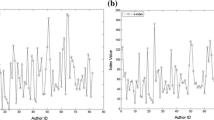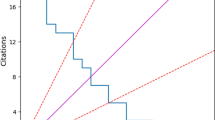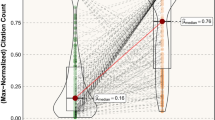Abstract
Nowadays identifying the personal representative works is becoming increasingly important and necessary for scientists in many cases, such as faculty hiring and promotion applications. There are already a few methods based on different criteria for selecting the representative works of a scientist, like citation count. In addition, we can observe that some researchers always produce many similar quality scientific papers and some researchers have several highly cited papers compared with his or her other papers. In this context, we propose to use the maximum gap in a histogram of a scientist’s sorted papers’ citation counts to classify his or her papers into two groups, i.e. representative papers and regular papers. Based on the maximum gap, we then design an indicator \(D_{r}\) to quantify the impact difference between scientist’s representative works and regular works. We apply this selection method and \(D_{r}\) index into the data of American Physical Society (APS) journals. The results indicate that the selection method can better identify the representative works of Nobel laureates in Physics compared with using the most cited paper. We also find that the number of representative works selected by our method is related to \(D_{r}\). A larger number of selected papers would appear when the value of \(D_{r}\) index is relatively smaller. Meanwhile, we also observe that \(D_{r}\) is weakly correlated with the h index and total citation.






Similar content being viewed by others
References
Bao, P., & Wang, J. (2018). Identifying your representative work based on credit allocation. Companion Proceedings of the The Web Conference, 2018, 5–6.
Bao, P., & Zhai, C. (2017). Dynamic credit allocation in scientific literature. Scientometrics, 112(1), 595–606.
Bergstrom, C.T., Foster, J. G., & Song, Y. (2016). Why scientists chase big problems: Individual strategy and social optimality. Preprint at arXiv:1605.05822.
Clauset, A., Arbesman, S., & Larremore, D. B. (2015). Systematic inequality and hierarchy in faculty hiring networks. Science Advances, 1(1), e1400005.
Fiala, D., Šubelj, L., Žitnik, S., & Bajec, M. (2015). Do PageRank-based author rankings outperform simple citation counts? Journal of Informetrics, 9(2), 334–348.
Foster, J. G., Rzhetsky, A., & Evans, J. A. (2015). Tradition and innovation in scientists’ research strategies. American Sociological Review, 80(5), 875–908.
Garfield, E. (1955). Citation indexes to science: A new dimension in documentation through association of ideas. Science, 122(3159), 108–111.
Hirsch, J. E. (2005). An index to quantify an individual’s scientific research output. Proceedings of the National academy of Sciences of the United States of America, 102(46), 16569–16572.
Ioannidis, J., Boyack, K. W., Small, H., Sorensen, A. A., & Klavans, R. (2014). Bibliometrics: Is your most cited work your best? Nature News, 514(7524), 561.
Larsen, P. O., & Von Ins, M. (2010). The rate of growth in scientific publication and the decline in coverage provided by Science Citation Index. Scientometrics, 84(3), 575–603.
Mariani, M. S., Medo, M., & Zhang, Y. C. (2016). Identification of milestone papers through time-balanced network centrality. Journal of Informetrics, 10(4), 1207–1223.
Medo, M., & Cimini, G. (2016). Model-based evaluation of scientific impact indicators. Physical Review E, 94(3), 032312.
Niu, Q., Zhou, J., Zeng, A., Fan, Y., & Di, Z. (2016). Which publication is your representative work? Journal of Informetrics, 10(3), 842–853.
Radicchi, F., Fortunato, S., & Castellano, C. (2008). Universality of citation distributions: Toward an objective measure of scientific impact. Proceedings of the National academy of Sciences of the United States of America, 105(45), 17268–17272.
Schlagberger, E. M., Bornmann, L., & Bauer, J. (2016). At what institutions did Nobel laureates do their prize-winning work? An analysis of biographical information on Nobel laureates from 1994 to 2014. Scientometrics, 109(2), 723–767.
Shen, H. W., & Barabási, A. L. (2014). Collective credit allocation in science. Proceedings of the National academy of Sciences of the United States of America, 111(34), 12325–12330.
Sinatra, R., Wang, D., Deville, P., Song, C., & Barabási, A. L. (2016). Quantifying the evolution of individual scientific impact. Science, 354(6312), aaf5239.
Zeng, A., Shen, Z., Zhou, J., Wu, J., Fan, Y., Wang, Y., et al. (2017). The science of science: From the perspective of complex systems. Physics Reports, 714–715, 1–73.
Acknowledgements
This work was supported by the National Natural Science Foundation of China (Grant Nos. 61603046 and 61374175) and the Natural Science Foundation of Beijing (Grant No. L160008).
Author information
Authors and Affiliations
Corresponding authors
Rights and permissions
About this article
Cite this article
Zhou, J., Zeng, A., Fan, Y. et al. The representative works of scientists. Scientometrics 117, 1721–1732 (2018). https://doi.org/10.1007/s11192-018-2918-0
Received:
Published:
Issue Date:
DOI: https://doi.org/10.1007/s11192-018-2918-0




